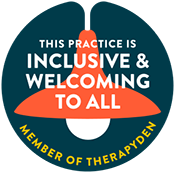
Therapy
for
Anxiety
and
OCD
Helping you navigate anxiety so you can be free to live your life with peace
You’ve always struggled with worrying too much and feeling anxious, and with stresses building up it’s getting worse. No matter what you do to stay on top of your anxiety, it doesn’t get better. You’ve tried everything and even when there’s some relief, anxiety returns quickly. Now it’s hard to focus on the things that matter, you’re exhausted all the time, and wonder when you will get to enjoy things in life.
With ERP therapy I’ll help you dismantle these fears and reduce your anxiety so you can live your life again.

“Do the thing you fear and the death of fear is certain.”
Hi, I’m Dr. Kelsey Harper
(She/hers)
I’m a clinical psychologist and I specialize in offering science-backed therapy for anxiety and OCD. Through ERP (Exposure and Response Prevention) therapy, I’ll help you decrease anxiety and overthinking, break down the barriers to living the life you want, and bring ease and joy back into your life.
My Approach
ERP (Exposure Response Prevention) is an evidence based therapy developed to treat symptoms of OCD including excessive worry and overthinking, obsessive thinking, compulsive behaviors like repetitive checking and cleaning. This type of therapy uses exposure-based techniques to free people from worries and fears, take back their life, and prevent OCD symptoms from occurring again.
Together we will assess your specific experiences and design exposure exercises tailored to you so you can break free from OCD. Exposure exercises help people face their fears in manageable steps so they can get out of their anxiety spirals without becoming overwhelmed. When exposure is paired with response prevention, we eliminate fear-related compulsive behaviors that interfere with living the life you want.
Learn more about OCD and ERP therapy here.
01
How It Works
How do I get started?
Click “Book Now” and schedule an initial appointment. I will call to discuss your interests and goals for therapy, and my approach to see if we’re a good fit before getting started. This call is brief, about 20 minutes and helps us get the lay of the land.
02
What happens next?
If we’re a good fit to work together, I’ll confirm the initial appointment and we’ll get started. In this session we’ll discuss some background and set up therapy goals together. We’ll discuss the next steps and you’ll leave session with a clear plan for our work together.
03
What happens next?
We’ll meet weekly for 50-minute sessions and work through the steps of your treatment plan. If at any time your goals change or something isn’t quite working, we can adjust so that therapy is effective for you and meets your needs.

Begin Now
What are your rates?
Individual therapy: $265 per session
Family or couples therapy: $285 per session
Group therapy: $90 per session
FAQ’s
Do you take insurance?
I am OUT OF NETWORK for all insurance plans. For out-of-network PPO plans, I can provide you a superbill to submit to your insurance for reimbursement, or you can utilize Mentaya to submit claims electronically and get reimbursed quicker.
I have partnered with Mentaya to help my clients save money on therapy. Check your benefits to see if you're eligible for reimbursement:
Please contact your insurance provider directly to verify benefits and coverage and ask any questions you might have about benefits.
Where do you provide therapy?
I offer virtual therapy (encrypted videoconferencing or phone) for people in AL, AZ, AR, CA, CO, CNMI, CT, DE, DC, FL, GA, ID, IL, IN, KS, KY, ME, MD, MI, MN, MO, NE, NV, NH, NJ, NC, ND, OH, OK, PA, RI, SC, TN, TX, UT, VA, WA, WV, WI, WY. This makes therapy accessible to everyone from the comfort of their own space!
What is OCD?
OCD, Obsessive Compulsive Disorder, is a disorder characterized by symptoms of obsessive thinking and compulsive behaviors that interfere with a person’s daily living, relationships, work, long term goals, and experiences of joy and fun.
Obsessive thinking is comprised of intrusive thoughts, unwelcome and distressing ideas, thoughts, images or impulses that repeatedly enter the mind. They may seem to occur against a person’s will or control. They may be scary and repulsive and often folx recognize them as senseless, irrational and they may not fit their personality.
Compulsive behaviors are acts that people feel driven to perform although they may recognize those acts as senseless or excessive. At times, people may try to resist doing these behaviors, but this may prove difficult or impossible. People may experience anxiety that does not diminish until the compulisve behavior is completed. Compulisve behaviors can be external like repetitive checking, hand washing, cleaning, seeking reassurance; and internal like rumination, excessive overthinking, problem solving and analyzing, counting, reminding oneself of something over and over again.
What is Generalized Anxiety Disorder?
GAD, Generalized Anxiety Disorder, is a disorder where a person feels excessive and ongoing anxiety for a broad range of issues with little to no relief. This includes symptoms of excessive worrying, restlessness, fatigue and exhaustion, irritability, difficulty concentrating and focusing, muscle tension and sleep disturbance. Despite efforts to manage anxiety, symptoms don’t change and interfere with daily living.
Can trauma cause OCD?
Yes, traumatic events can contribute to developing and presenting symptoms of OCD. In response to traumatic experiences, a person may develop intrusive and repetitive thoughts and images, and compulsive behaviors to manage painful emotional experiences.
Is ERP right for me?
ERP is quite helpful for people who have tried to control their thoughts and behaviors with different coping skills, and find their symptoms don’t change. ERP is shown to quickly reduce OCD symptoms, prevent future relapse of symptoms, and help people build a life worth living. My clients use ERP to stop the anxiety rollercoaster, build effective skills to use to support ongoing recovery, and connect with their lives.
Can I use ERP if I have trauma?
Yes, ERP can be very helpful for people who have trauma-based OCD. Initially, we would start with trauma focused therapy like EMDR to repair trauma symptoms you may be experiencing, and then would implement ERP to reduce intrusive thoughts and compulsive behaviors.
Break free from OCD
**Neville, therapy floof







